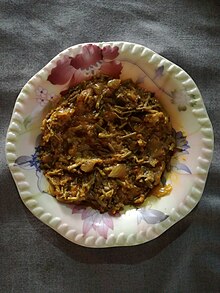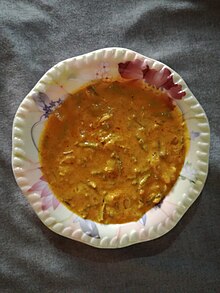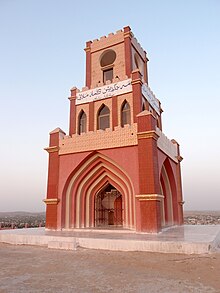Tharparkar (Sindhi: ٿرپارڪر, Urdu: تھرپارکر), also known as Thar, is a district in Sindh province in Pakistan headquartered at Mithi. The district is the largest in Sindh, and has the largest Hindu population in Pakistan. It has the lowest Human Development Index rating of all the districts in Sindh. Currently the Sindh government is planning to divide the Tharparkar district into Tharparkar and Chhachro district.
History
The name Tharparkar originates from a portmanteau of the words Thar (referring to the Thar Desert), and parkar (meaning “to cross over”). The Thar region was historically fertile, although it was mostly desertified between 2000 and 1500 BC. Before its desertification, a tributary of the Indus River was said to flow through the region; it is speculated by some historians that this river could be the ancient Sarasvati River mentioned in the Hindu Rigveda. The Thar region is also mentioned in the Ramayana, where it is called “Lavanasagara” (meaning “salt ocean”).
Sindh was ruled by various dynasties after the fall of the Indus Valley civilisation. These dynasties included the Soomras), the Sammas, the Arghuns, the Kalhoras, and the Talpurs. These rulers mainly focused on the central and western parts of Sindh while the eastern areas, including Tharparkar were largely disregarded. In 1843, as a part of the British invasion of the Indian subcontinent, Charles James Napier (the Commander-in-Chief of the British Army) defeated the Talpur dynasty and conquered Sindh. The conquered areas, including Tharparkar, were incorporated into the Cutch Agency and Hyderabad Collectorate. The British government divided Sindh in provinces, administered by British-appointed Zamindars.
Sindh was later made part of Bombay Presidency. In 1858, the entire area around Tharparkar became part of Hyderabad, and in 1860 the region became part of the newly organized Eastern Sindh Frontier which was headquartered at Amarkot. In 1882 it was reorganized as a district, headed by a Deputy Commissioner. In 1906, the district headquarters was moved from Amarkot to Mirpur Khas. On 31 October 1990 the district was divided into the Tharparkar and Mirpur Khas Districts. On 17 April 1993, Umerkot District was carved out of Tharparkar.
Geography
Tharparkar district lies between 69° 3′ 35″ E and 71° 7′ 47″ E longitudes, and between 24° 9′ 35″ N and 25° 43′ 6″ N latitudes. To its east, the district borders the Jaisalmer, Barmer and Jalore districts of Rajasthan in India. To the south it borders the Kutch district of Gujarat in India. Umerkot district lies to its north while Badin and Mirpur Khas districts are to its west.
Climate and environment
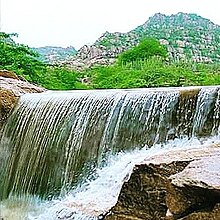
Nagarparkar after rains

Tharparkar scorpions
The district has a tropical desert (Köppen: BWh) climate. During summer, it is extremely hot during the day, while nights are much cooler. April, May and June are the hottest months and December, January and February are the coldest months. The mean maximum and minimum temperatures during winter are 28 °C and 9 °C, respectively. There are wide fluctuations in annual rainfall and the yearly average in some areas is as low as 100 mm. Most precipitation occurs between July and September, during the south-west monsoon.
| Year | Mithi | Islamkot | Diplo | Kaloi | Chachro | Dahli | Nagarparkar |
|---|---|---|---|---|---|---|---|
| 2014 | 180 | 167 | 33 | TNC | 7 | TNC | 43 |
| 2015 | 422 | 362 | 512 | TNC | 363 | 26 | 588 |
| 2016 | DU | DU | DU | DU | DU | DU | DU |
| 2017 | 261 | 337 | 379 | 11 | 1 | 123 | 324 |
| 2018 | 58 | 24 | 51 | 10 | 10 | 120 |
Flora

A type of crown flower, known locally as Ak, growing in Tharparkar.
There are at least 89 plant species of 26 plant families native to Tharparkar. Many species of herbs grow during the wet season while desert shrubs and drought resistant trees grow year-round.
Fauna

Sparrows in Tharparkar

A chinkara, also known as the Indian gazelle
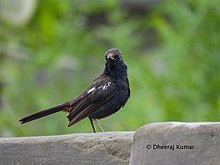
An Indian robin in Tharparkar

A Tharparkar lizard resting on a branch
Wealth of fauna is considered as a salient feature of this region. From folk music to designs and art work since ancient times have included fauna of Thar as integral part. Fauna of Thar is also part of art, culture, heritage and great histories.
Sanctuaries
Chinkara wildlife sanctuary
The Chinkara Wildlife Sanctuary covers 940 km2 in Tharparkar where the hunting of wildlife and poaching is prohibited. The prohibition extends from Chelhar in the north, to Bhorelo in the southeast, and to Mithi and Wajatto in the west.
Vulture and migratory birds sanctuary

One of Tharparkar’s venomous snakes
Tharparkar has been designated a major sanctuary for endangered species of vulture, while Gorano has been declared a habitat for several migratory birds.
Peafowl conservation efforts in the district focus on preventing the further endangerment and death of animals that are significant as symbols of Tharparkar. In addition, illegal exploitation of scorpions and snakes has been reported in the area.
Human Development
The Human Development Index (HDI) of Tharparkar is 0.227. In Pakistan’s 2017 HDI report, Tharparkar ranked 109th out of 114 surveyed districts, a drop from its rank as 103rd in 2013, the lowest ranking of any district in Sindh. Tharparkar also ranked among the ten worst districts for HDI growth between 2005 and 2015.
Poverty
The UNDP’s Multidimensional Poverty Index for Pakistan reports that 87% of population in Tharparkar live under poverty. Due to Tharparkar’s poor conditions, including its low HDI and high infant mortality rate, a monitoring commission was formed to oversee the Sindh government’s administration of the district.
The Benazir Income Support Programme and the United Nations’ World Food Programme agreed to take steps to reduce food insecurity in Tharparkar. In 2019, Pakistan was provided with US$362,000 and 4,727 mt of food assistance.
As a part of humanitarian efforts, 287,000 families in Tharparkar each received 50 kg of wheat 12 times. Additionally, 500 houses were provided to house Thari people. 750 small-scale water plants were constructed in the district at a cost of Rs 7.5 billion. The Thar Foundation, a joint venture of the Sindh government and Engro has planned to build a 250-bed hospital at a cost of Rs 2 billion in Tharparkar. The first 82-bed block was completed in February 2019.

Hunger and malnutrition are the biggest issues in Tharparkar. Each year, around 1,500 children die in the district.
Despite humanitarian initiatives by provincial, federal and international authorities, the region has seen little improvement, especially in its infant mortality rate, which sees around 1,500 children die annually. Between January and October 2019 84 infants died, while in total, 703 children died. In 2016, the National Commission for Human Rights (NCHR) directed the Sindh Chief Secretary to submit a report on cases of infant mortality.
According to Saeed Ghani, Sindh’s minister for Local Government, Public Health Engineering and Rural Development, and Katchi Abadies, a mobile app was introduced to assist with the distribution of wheat. However, no such app was actually created, and the system continues to rely on XLS/PDF files, and web resources, that weren’t widely distributed.
According to legislator Mahesh Kumar Malani, Rs 15 billion has been spent for development projects in nine years and further development plans worth Rs 18&nsbplbillion are under way to improve the situation in Tharparkar. According to the Chief Minister of Sindh Rs 70 billion has been spent on the development of infrastructure. The government’s Benazir Income Support Programme has transferred Rs 387 billion since 2008. Despite these efforts, the living standard index of Tharparkar has fallen by 50% between 2005 and 2015.
Although Tharparkar has been affected by drought for at least 17 years, and has been a subject of efforts of numerous major NGOs, including USAID, DFID and several branches of the United Nations, no detailed, statistical report on water resources and measures to improve the situation has been published by the government.
Health facilities and immunization
Thari people face various issues due to waterborne diseases, inadequate health facilities, famine, and lack of basic infrastructure.
Health facilities
As of 2014, there were 140 health facilities in the district, including a district headquarters hospital with a capacity of 50 beds and 3 tehsil headquarters hospitals with capacities of 80 beds each. When compared to World Health Organization standards, these facilities were sufficient for only 54% of the population, while bedding capabilities were sufficient for only 6%. In Tharparkar, an average 85% of births take place at home, with home births constituting 56% of urban births and 87% of rural births. Tharparkar ranks lowest in Sindh for births assisted by skilled attendants, with only 16% deliveries performed in that manner.
| Type | June 2012 | March 2019 |
|---|---|---|
| Teaching Hospitals | 0 | DU |
| District headquarter hospital | 1 | 1 |
| Tehsil headquarter hospitals | 3 | 1 |
| Rural health centres | 2 | 2 |
| Basic Health units | 31 | 36 |
| Govt. Rural Dispensaries | 101 | 38 |
| MCH centres | 2 | DU |
| Sub health centres | 0 | DU |
| Total | 140 | 78* |
Immunization
On average, only about 25% of pregnant women receive tetanus toxoid injections (25% in rural areas and 37% in urban areas). The overall percentage of infants aged 12–23 who receive full immunization is 21%. Urban areas saw a 32% immunization rate (16% of males and 48% of females), while rural areas saw a 20% rate (26% of males and 14% of females.
Comparison

Change in HDI compared to provincially and federally top HDI
| Year | Karachi | Lahore | Tharparkar | Rajanpur | Awaran | Kohistan |
|---|---|---|---|---|---|---|
| 2005 | 0.812 | 0.811 | 0.303 | 0.441 | 0.067 | 0.155 |
| 2007 | ||||||
| 2009 | ||||||
| 2011 | ||||||
| 2013 | ||||||
| 2015 | ||||||
| As of 2015 | Provincial Top HDI | Federally Top HDI | Lowest in Sindh | Lowest in Punjab | Lowest in Balochistan | Lowest in KPK |
| Rank change in 2 years(2013-2015) | +7 | 0 |
| Components | Karachi | Lahore | Tharparkar | Rajanpur | Awaran | Kohistan |
|---|---|---|---|---|---|---|
| Immunization rate (%) | 80.2 | 89.5 | 38.1 | 90.7 | 85.2 | 21.9 |
| Satisfaction with health facility (%) | 82.5 | 85.8 | 57.0 | 65.2 | 83.3 | 56.9 |
| Expected years of schooling (years) | 11.8 | 12.2 | 6.4 | 7.1 | 5.9 | 5.5 |
| Mean years of schooling (years) | 7.7 | 7.5 | 2.3 | 2.0 | 2.5 | 1.3 |
| Living Standard (%) | 98.5 | 98.9 | 7.5 | 48.9 | 1.9 | 12.5 |
| Karachi | Lahore | Tharparkar | Rajanpur | Awaran | Kohistan | ||
|---|---|---|---|---|---|---|---|
| MPI (value) | 0.019 | 0.017 | 0.481 | 0.357 | 0.415 | 0.581 | |
| Population in multidimensional poverty (%) | Incidence – Headcount | 4.5 | 4.3 | 87 | 64.4 | 77.2 | 95.8 |
| Intensity | 42.4 | 38.8 | 55.2 | 55.4 | 53.8 | 60.6 | |
| Contribution of deprivation to overall poverty (%) | Education | 57.5 | 65.6 | 38.8 | 44.3 | 38.4 | 41.9 |
| Health | 12.4 | 11.7 | 18.0 | 22.2 | 18.1 | 24.1 | |
| Living Standards | 30.2 | 22.6 | 43.2 | 33.6 | 43.5 | 34.1 |
Livelihood
Tharparkar district is predominantly rural, with 96% of the population residing outside of urban areas. The primary economic activity of the district is agriculture, while the much smaller urban population carries out activities related to agriculture. While the main food source and economic base of Tharparkar comes from livestock management, farming and artisanry are also important factors.

Thari women working in a field
Farming
Despite the arid climate and generally poor conditions for growing crops, the majority of the Thari people are employed by some form of farming. Most of the area relies on scant rainfall to irrigate farmland, however, in some areas of Nagarparkar taluka, tube wells are used. 1,014,000 (50.4%) of the district’s 2,011,000 hectares of land are cultivated.
Livestock
94% of the district’s households own some form of livestock, while 77.64% of the population is actively engaged in livestock management. The average household owns 8 animals, and an estimated 7.7 million animals make up the total livestock population of the district. Sheep are especially important to the district’s livestock economy, with 3 million kg of wool produced annually. Tharparkar holds 40% of Sindh’s sheep population, and is considered the most suitable area for sheep in the province. 70.3% of farms use animals as a source of power for plowing land. The percentage of donkeys in the livestock population is notably high, especially for an arid region, with the percentage in Tharparkar being higher than other areas in Pakistan. Despite the size and economic importance of the livestock population, only 12 veterinarians serve the district.

Thari camel herd
| Livestock | Population | Breeds |
|---|---|---|
| Cattle | 752,265 | Tharparkar, Kankrej |
| Buffalo | 46,328 | Kundhi |
| Sheep | 1,185,122 | Kooka Magra, Sonadi, Kachhi Marwari |
| Goat | 2,217,876 | Tharki, Kamori, Chappar |
| Camel | 135,356 | Dhatti |
| Horse | 8,519 | Baluchi |
| Mule | 1,475 | |
| Donkey | 246,657 | Ghudkhur |
| Domestic Poultry | 263,431 | |
| Total | 4,857,029 |
Thari woman working on a Charkha (spinning wheel)
Handicrafts
Art and artisanry have been part of Thari society since the Indus Valley civilisation. Common handicrafts include ralli, pottery, puppet-making, carpet-making, traditional decoration, block printing, cobbling, and embroidery, among others. In Chachro taluka alone there are 6,000 handlooms, despite the lack of a centralized facility. The sale of these products supplement local incomes, and provide economic opportunities, especially for women.
Politics
Between 2002 and 2018, the district was represented in the Provincial Assembly of Sindh by constituencies 60, 61, 62, and 63. The 2008 elections saw three of those constituencies represented by members of the Pakistan Muslim League (Q) (PMLQ), and one by a member of the Pakistan Peoples Party (PPP). During the 2013 elections, three candidates from the PPP and one from the Pakistan Muslim League (N) won.
Before 2018, Tharparkar was represented in the National Assembly by constituencies 229 and 230. During the 2008 elections, both were won by candidates of the PMLQ, while in the 2013 elections, they were both won by candidates of the PPP.
After a new delimitation of constituencies in 2018, the district is represented in the Provincial Assembly by constituencies 54, 55, 56, and 57, while in the National Assembly, it is represented by constituencies 221 and 222. In the 2018 elections, both national constituencies and three of the four provincial constituencies were won by the PPP, while one provincial seat was won by the Grand Democratic Alliance.
Industry and infrastructure
Industry
Coal
Pakistan’s estimated 185.175 billion tonnes of lignite coal reserves are the 7th largest in the world. Tharparkar district alone is estimated to hold 175.506 billion tonnes (95%) of the national reserves, the energy contents of which would surpass the combined energy of the resource reserves of Saudi Arabia and Iran.
In Pakistan, companies generating power are completely exempted from the payment of income tax, as well as turnover tax. Additionally, imports from prospective sponsors of coal power generation projects are exempted from tariffs. This is done in order to encourage investment in the country’s energy sector. Such investments have included a 600 MW producing project implemented by the Chinese Shenhua Group, and the 1200 MW producing Thar Engro Coal Power Project.
In Pakistan, mineral mining operations are subject to provincial administration. However, in 2011, to encourage large-scale investment in coal mining, the federal government authorized the creation of the “Thar Coal & Energy Board” (TCEB), a statutory corporation that would directly administer the extraction and use of Tharparkar’s large energy resources.
In March 2019, new members were appointed to the TCEB including female Member of National Assembly (MNA) Shazia Marri (NA-216). However, the TCEB’s charter requires that there should be one female MNA from either Tharparkar, Umerkot or Mirpur Khas districts on the board. An exception was made, as MNA Mahesh Malani and Senator Krishna Kohli were from and represented the Thar region, despite neither directly fitting the “female MNA from Thar” requirement.
The Sindh Engro Coal Mining Company in Tharparkar supplies electricity to the national grid. Despite this, the large majority of the 2,300 registered and almost 2,000 unregistered Thari villages have no electricity supply. Energy shortages and blackouts are common, and one outage during a heat wave lasting 22 hours resulted in the deaths of several hospital patients. An informal announcement made by the Sindh government declared that electricity would be freely provided to Tharparkar, however this has not happened, and electricity continues to be supplied by private companies such as Hyderabad Electric Supply Company.
Several entities have raised issues of potential environmental and health impacts that could result from extensive coal mining and use. The pollution and harm to the environment caused by coal mining and use in the region have led to destruction of habitat, as well as the large-scale displacement of local communities. Health effects of lignite pollution include increases in the risk of cancer, as well as heart and lung problems. Social movements, which some Thari people are involved in, have hoped to address these challenges.
Solar

Solar potential of Tharparkar compared to Bahawalpur (having Pakistan’s largest solar power plant)
Bahawalpur district’s Quaid-e-Azam Solar Park, the largest photovoltaic power station in Pakistan, has a photovoltaic electricity output (PVOUT) of 1596 kWh/kWp per year and a global horizontal irradiance (GHI) of 1925 kWh/m2 per year. In comparison, Tharparkar has a PVOUT of 1642 kWh/kWp per year and a GHI of 2005 kWh/m2 per year.
In January 2015, at a cost of US$2.98 million the largest solar reverse osmosis plant in Asia was completed in Mithi with the ability to filter two million gallons of water daily. Throughout the district, smaller plants, each with filtration capacities of 10,000 gallons per day were installed at cost of around US$24,900 each. These plants were the result of cooperation between the Sindh provincial government and Pak Oasis, a water treatment company. Despite such initiatives, much of the arid region continues to suffer from a lack of clean drinking water, resulting in sickness and death.
The efficacy, political motivations, and administration of these plants have been called into question, and as a result of a four-month lapse in pay, workers went on strike in October 2018, causing a significant water crisis.
In July 2018, Pakistan’s National Accountability Bureau began an investigation of an alleged illegal awarding of a contract to Pak Oasis. Allegations included a premature payment of Rs 5 billion to Pak Oasis prior to their completion of a water treatment project.
In October 2018, the Chief Minister of Sindh authorized the use of Rs 336.7 million for the construction of 110 reverse osmosis plants. In November 2018, Sindh Government decided to takeover all RO plants in Thar Coal Block-II.
On 16 April 2019, MPA Sidra Imran claimed in a speech in the Provincial Assembly of Sindh that 700 solar reverse osmosis plants, worth Rs 8 billion, were not functional.
Transportation
Road
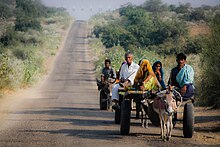
Donkey-drawn cart used for transportation
Only 743 km of quality roads run through the 19,638 km2 of Tharaparkar district, considered inadequate by the standards of several NGOs.[77] Major cities of the province are connected by a highway, and the talukas of the district are connected to the district headquarters of Mithi by several metalled roads.
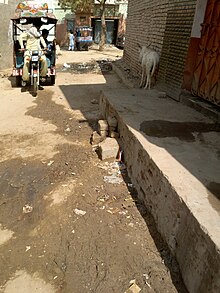
Local chinchi (rickshaw) transportation

A jeep moving in the Thar Desert
| Destination | Road (km) |
|---|---|
| Karachi (via Thatta / Badin) | 300 |
| Karachi (via Hyderabad / Mirpurkhas) | 400 |
| Karachi (via Mirpurkhas / Umerkot) | 425 |
| Nagarparkar | 150 |
| Badin | 100 |
| Naukot | 50 |
| Umerkot | 85 |
Airport
The Civil Aviation Authority of Pakistan (PCAA) constructed an airport in Islamkot at a cost of around Rs 972.07 million. The Islamkot International Airport covers 1,000 acres and has a 3 km long runway, and serves both civilian and military air traffic. The Sindh Coal Authority requested the construction of the airport, as the new infrastructure would contribute to the development of the nearby Thar coalfield.
The airport lies within 80 km (50 mi) of Pakistan’s border with India, and clearance for the construction of the airport was given by the Pakistani Ministry of Defence on 25 September 2009. The airport was first inaugurated on 17 July 2017 by Chief Minister Murad Ali Shah as Thar Airport. It was inaugurated again on 11 April 2018 by Bilawal Bhutto Zardari, when its name was changed to Mai Bakhtawar Airport. However, the PCAA does not recognize the airport, and the airport, which has no official website, lacks an official ICAO or IATA code.
Railway
Before the partition of India and creation of Pakistan in 1947, the Sind Mail ran between Hyderabad, Pakistan and Ahmedabad, India via Mirpur Khas, Khokhropar, Munabao, Barmer, Luni, Jodhpur, Pali, Marwar and Palanpur. Post-partition, service continued on the line, with Khokhropar railway station, the last station in Pakistan, used for customs. However, service on that line was stopped after the Indo-Pakistani War of 1965. The town of Khokhropar and the rest of the Nagarparkar salient were captured by India in the Indo-Pakistani War of 1971, but were returned to Pakistan in 1972.
On 18 February 2006, after a 41-year suspension, service on the Hyderabad – Jodhpur railway line resumed after the conversion of metre gauge track to broad gauge track. The newly constructed Zero Point railway station near the border town of Khokhropar in Dahli taluka is now the last station in Pakistan on the Hyderabad – Jodhpur line, and so is used in customs enforcement.
The Thar Express, which runs weekly between Karachi and Jodhpur, is operated by Pakistan Railways and Indian Railways. The 700 km journey takes a relatively long 32 hours, and so is nicknamed the ‘torture train’ by some passengers.
Despite formal Thari petitions for rail service to facilitate migration during drought, government efforts focus on the improvement of coal mining infrastructure.
Telecommunications
In March 2009, the Pakistani Ministry of Information Technology’s Universal Service Fund awarded a Rs 930 million contract to Telenor Pakistan for the building of basic telephone and data infrastructure in Tharparkar.
In March 2017, Sindh Engro Coal Mining Company, in partnership with Wateen Telecom, introduced free Wi-Fi to two villages, as the first stage of a larger initiative. The villages of Tharyo Halepoto and Senhri Dars near Islamkot were provided with 3 Mbit/s internet service at no charge. A second phase of the initiative aims to provide the same service to all schools in Thar Coal Block II. Future phases aim to extend service to the entirety of Thar Coal Block II. Questions have been raised about the scale of benefits of free Wi-Fi to a district where 87% of the population lives in absolute poverty.
Paid telecommunications services in Tharparkar are dominated by Pakistan Telecommunication Company Limited (PTCL), which has a monopoly on telecommunication in Pakistan.
Water resources

Women and children fetching water
Access to drinking water in Tharparkar is very poor. Only 47% of the population has access to drinking water. Wells are crowded and their supply strained, as 60% of households wait more than an hour at wells for their turn, and 30% households spend more than Rs 30 for two buckets of water. 85% of households use akhaal (rubber bags carried by a camel or donkey) to carry water, while 25% use buckets carried by camel or donkey. In some areas, single journeys for water may take as long as two days. 75% of women travel an average 3 km per trip, spending 52% of their working hours fetching water.[12][162]
| Type | 2010-11 | 2014-15 | ||||
|---|---|---|---|---|---|---|
| Total | Urban | Rural | Total | Urban | Rural | |
| Tap Water | 13 | 79 | 10 | 6 | 67 | 1 |
| Hand Pump | 2 | 1 | 2 | 7 | 9 | 7 |
| Motor Pump | 2 | 20 | 1 | 3 | 0 | 4 |
| Dug Well | 77 | 0 | 81 | 75 | 20 | 79 |
| Others | 5 | 0 | 0 | 8 | 3 | 9 |
| Electricity | Gas/Oil | Wood & Candle | Other | ||||||||
|---|---|---|---|---|---|---|---|---|---|---|---|
| Urban | Rural | Total | Urban | Rural | Total | Urban | Rural | Total | Urban | Rural | Total |
| 93.44 | 34.06 | 38.55 | 0 | 10.24 | 9.47 | 0 | 14.42 | 13.33 | 6.56 | 41.28 | 38.65 |
Irrigation
As the district is mostly arid, its irrigation system is small. Only 1.6% of the district’s cultivated land is irrigated, mostly in Diplo taluka by a tributary of the Naukot branch of Nara Canal. Irrigation is most extensive in Nagarparkar and Mithi, where much of the land is fed by tube wells.
Fuel
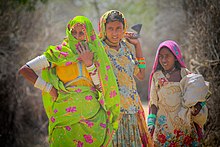
Women set out to collect firewood

An example of Jugaad
In Tharparkar, 99% of households use firewood as the main fuel supply for cooking. The deforestation resulting from large-scale firewood harvesting is a potential contributor to Tharparkar’s drought issues. The second largest supply is gas, which 0.7% of households use. Most gas use is in Tharparkar’s smaller urban communities. Gas infrastructure is poorly developed, and gas cylinder safety is questionable, which has led to some accidents. One common solution to gas safety problems used in Tharparkar is the Jugaad practice of placing a heavy object on top of a faulty valve, to prevent gas from leaking.
| Gas | Wood/Sticks | Oil | Other | ||||||||
|---|---|---|---|---|---|---|---|---|---|---|---|
| Urban | Rural | Total | Urban | Rural | Total | Urban | Rural | Total | Urban | Rural | Total |
| 9.36 | 0 | 0.71 | 90.64 | 99.76 | 99.07 | 0 | 0.08 | 0.07 | 0 | 0.16 | 0.15 |
Finance, banking and taxation
Finance
Tharparkar’s importance to the Sindh and Pakistani economies is mostly based in its energy reserves and its status as the energy capital of Pakistan. During the September 2019 Pakistan Renewable Energy Summit, President Arif Alvi reemphasized the importance of fully utilizing the coal reserves discovered in Tharparkar. To fulfill this aim, the Sindh government called for further Australian investment in Thar coal, and auctioned off 4 coal mining blocks worth between US$4–6 billion.
Chinese investment in the district includes a US$2 billion investment from the Chinese state-owned Shanghai Electric Power Company Limited. As of November 2019, Pakistan and China have agreed to expand the scope of the China–Pakistan Economic Corridor to include copper, gold, oil, gas, and housing sectors.
In 2019, the Manila-based Asian Development Bank approved a $75 million loan for investment in the Sindhi education system. Also in 2019, the World Bank approved a $1.93 billion loan to Sindh to be used in several initiatives with various goals, including the development of Tharparkar’s rural economy. Since, this occurred just after Sindh CM was summoned by the National Accountability Bureau (NAB) in graft probe, has raised concerns among people. However, questions have been raised about possible misuse of such funding.
Industrial investments in the district have been promoted by the government, with important economic incentives having been implemented in Tharparkar to attract businesses. Serious issues of industrial slave labor and worker exploitation exist in the district.
258:24:21
A routine activity in Tharparkar
Banking
Like the rest of Pakistan, domestic banking in Tharparkar is conducted interest-free as a result of previous Islamization of banking. However, foreign loans and deposits of foreign currency do incur interest. Most banks in Tharparkar are concentrated within urban centers such as Mithi, and are closed on Saturdays and Sundays. Online banking services in the district are limited.
Taxation
All personal and corporate incomes are taxed by the federal government except income from agriculture which is taxed by provincial governments. In Sindh, Board of Revenue (BOR) collects all tax revenue of the Government of Sindh. As per Sindh Agricultural Income Tax Act of 2000, no land tax is levied in the Thar Desert and the Kohistan areas. An amendment bill was passed by the Provincial Assembly of Sindh on 30 April 2018 and further formal notification was issued on 22 May 2018 for the same. The Sindh cabinet during same time also decided to amend the Sindh Arms Act, allowing people to keep more than four (as many weapons as desired) weapons. Further asset statements provided by legislators and senators for the year 2018 revealed alarming figures of arms and deadly-military weapons in their personal arsenals. Apart from this, Home secretary was summoned in sale of weapons on fake arms licenses case by an anti-terrorism court. In second week of November several reports described Federal Board of Revenue (FBR) is to be restructured and Prime Minister has proposed for replacement of FBR.
Demographics
At the time of the 2017 census, Tharparkar district had a population of 1,647,036, of which 881,018 were males and 765,862 females. The rural population was 1,514,502 (91.95%) and urban 132,534 (8.05%). The literacy rate is 29.78%: 41.95% for males and 16.61% for females.
| Year | Mithi | Islamkot | Diplo | Kaloi | Chachro | Dahli | Nagarparkar |
|---|---|---|---|---|---|---|---|
| 1998 | 125,137 | 137,826 | 92,047 | 73,651 | 167,235 | 165,289 | 153,106 |
| 2013 | 201,850 | 190,664 | 230890 | DU | 232,210 | 225,710 | 218,411 |
| 2017 | 219,901 | 244,439 | 148,871 | 117,609 | 350,807 | 305,529 | 259,880 |
Languages[edit]

An example of the differences in dialects of Dhatki, the most widely spoken language in Tharparkar
Languages of Tharparkar district (2017)
In the 2017 census, 98.74% of the population recorded their language as ‘Sindhi’ on the census. However Tharparkar is home to a wide variety of dialects, lying at the transition zone between Sindhi, Rajasthani and Gujarati. Dhatki, which is the most widely used, is closely related to Marwari on the other side of the border, and transitions to Sindhi in the west. Other languages include the various Koli languages such as Parkari and Kachi Koli spoken in the southeast near the border with Gujarat.
Religion

Churrio Jabal, the site of Durga Mata Temple

A temple in Chelhar
Before the partition of India in 1947, Hindus and Muslims constituted roughly 80% and 20% of Tharparkar’s population, respectively. Post-partition, many Hindus, especially those of the upper castes and their servants, emigrated to India, while roughly 3,500 Muslim families immigrated to Tharparkar from India. The immigrating families were given 12 acres of land each (a total of 42,000 acres).
In the 1998 census, 59.42% of the district’s population was Muslim and 40.47% Hindu. As of the 2017 census, Muslims are 56% while Hindus make up 43%. Hindus make up 64% of Tharpakar’s urban areas, while Muslims make up 58% of rural areas. Tharparkar today has the largest Hindu population in Pakistan.
| Level | Number of schools | Students | Male | Female | Teachers | Male | Female | Student-teacher ratio | Classrooms (average) |
|---|---|---|---|---|---|---|---|---|---|
| Primary | 3,873 | 190,370 | 105,494 | 84,876 | 4,625 | 4,057 | 568 | 41 | 1 |
| Middle | 234 | 15,052 | 8,587 | 6,465 | 362 | 344 | 18 | 42 | 2 |
| Secondary | 40 | 12,130 | 7,833 | 4,297 | 403 | 333 | 70 | 30 | 7 |
| Higher secondary | 5 | 3,651 | 3,275 | 376 | 79 | 79 | 0 | 46 | 17 |
| Total | 4,152 | 221,203 | 125,189 | 96,014 | 5,469 | 4,813 | 656 | 40 | 1.1 |
University
In April 2019, a large social media movement using the hashtag #TharNeedsUniversity and protesting the lack of a university campus in Tharparkar district demanded the establishment of such an institution. The movement prompted the government to take measures to establish a sub-campus in Islamkot. NED University of Engineering and Technology, in partnership with Sindh Engro Coal Mining Company (SECMC) and The Citizens Foundation (TCF), announced the creation of the “Thar Institute of Engineering, Science, and Technology” in Islamkot, which would be a sub-campus of NED. An undergraduate programme was planned to commence in October 2019, although instruction was planned to take place at the TCF-Engro Campus Islamkot until a more permanent campus could be established.
However, the location of the future campuses was moved after the Sindh government purchased 317 acres of land in Mithi for Rs 1.5 billion. In addition, the temporary location was moved from the TCF-Engro Campus in Islamkot to the Benazir Cultural Complex in Mithi after payment of Rs 120 million by the Sindh government. In October 2019, the temporary NED University campus was inaugurated at the cultural complex in Mithi, although several weeks after the planned date for the cancelled Islamkot campus.

A Thari patko, a traditional type of turban
Culture and tradition
Tharparkar is considered the most peaceful place in the entire country and is well known for its centuries-old interfaith harmony. The culture of Tharparkar is an exemplary example of pluralism in Sindh. Muslim residents do not sacrifice cows, not because of any laws but to avoid causing offense to the Hindu community. Hindu residents avoid weddings and celebrations during Muharram (an Islamic month notable for its solemn mood). Hindus also fast and arrange Iftar dinners for their Muslim neighbors in the month of Ramadan, and both sides exchange sweets on Eid and Diwali. Muslim residents also avoid eating any meat during the Hindu occasion of Navratri. According to Dawn, there appears to be no recorded instance communal violence in the district.
Another unique feature of the district’s culture is its relatively low crime rate. Normally, crime is associated with poverty, yet in this district the crime level is low despite its poverty and unemployment level.
Cuisine
|
Guar is a major food crop in Tharparkar and Guar Chibhad ji bhaaji is among popular dishes. |
Singhri(Sangri) grows in arid or desert climates throughout year in Thar and Singhrian ji Bhaaji is prepared from it. |
Achar is prepared from fruits and flowers of Kair. Also vegetable dish known as Kairan (or Doran) ji Bhaaji is prepared. |
Singhrian jo Raabro (Khaatiyo) is one of variant of Singhri vegetable dish prepared with Kadhi. |
Thari people are predominantly vegetarian. Singhri (Sangri), Kair and Guar are among most popular in Thar.[
Festivals
Various festivals in Thar include:

Sattu is prepared for Teejdi (or Teej) festival

Lola (Lolo in singular) prepared on Thadri by Sindhis
Teejdi
Teejdi (known among Sindhis) also known as Teej or Kajari Teej is celebrated in Thar on Tritiya-Krishna Paksha of Bhadrapada. During this festival the women observe fast and also pray to the moon when it rises. While prayers to moon 5 leaves of Ak(2 below Pāda, 2 in īrmá and 1 on Śiraḥ ) are kept and Argh is offered. After the prayers, fast is broken by consuming some Argh and Sattu on another leaf of Ak. The fast is observed by married women for health of their husband while unmarried women pray for marital bliss.
Thadri
Thadri festival is celebrated by Sindhis, one tithi before Krishna Janmasthmi during which cold (i.e. cooked a day ahead) and pro biotic foods like yogurt and pickle are consumed. Thadri reflectes a tribute to Sheetla Mata.
Chetichand
Cheti Chand is celebrated by Sindhi Hindus. It is the festival which marks the beginning of the Hindu New Year for Sindhi Hindus. It is celebrated on first day of the Sindhi month Chet (Chaitra).
Naurata
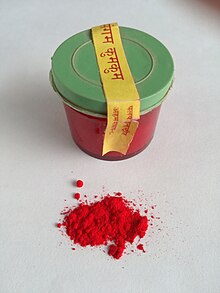
Kumkuma is applied on sing of Gou Mata during Gou Puja on Dhanteras.

Gadi Bhit monument view
Gadi Bhit is the highest elevation point of Mithi which is built on a sand hill giving panoramic view of entire town.
Churrio Jabal
Churrio Jabal (چوڙيو جبل ) is a historic Durga Mata Temple on the Churrio hill which is visited annually by 200,000 pilgrims from Nepal, India and other countries annually on Shivratri. Hindus bring cremated ashes of their departed beloveds to immerse in the holy water. The valuable and multi-coloured hill supporting the temple is mined for its rare and expensive granite, which is posing a serious threat to the hill and this ancient Hindu temple.
Marvi Jo Khooh (Marvi’s Well)
Marvi Jo Khoh (Marvi’s Well) is heritage of Sindh located near village Bhalva in Tharparkar.
Sant Nenuram Ashram / Puranbharti Ashram

Sant Nenuram Ashram
Sant Nenuram Ashram (سنت نيڻورام آشرم ) also known as Puranbharti Ashram (پرڻڀارتي آشرم ) or Aakharo (آکاڊون) was established by Nihalchand Pabani(Neem Revolutionist) in Islamkot (also known as Neem Town or Sant Nenuram Nagri). The Ashram each day twice throughout year serves Bhandhara which is available for everyone. Daily large number of people from different caste, creed, race or religion avail this meal. Apart from this daily huge number of birds (especially Crows, Raven and Peacock) are fed Nukti-Bhujia in Ashram by devotees visiting the Ashram. An annual three-day festival of Sant (Sant Jo Melo) is celebrated by thousands of devotees including both Hindus and Muslims. The annual festival is celebrated in Ashwina month of Hindu Calendar beginning from Tritiya-Krishna Paksha(Andhari Teej) to Panchami-Krishna Paksha(Andhari Pacham).
Karoonjhar Mountains
Karoonjhar Mountains are located near Nagarparkar on the northern edge of the Rann of Kutch with approximately 19 km length and height of 305 m.
Administration
Tharparkar District is divided into 7 Tehsils, 64 Union Councils, 172 Dehs, and 2,365 villages.

Map of Tharparkar District’s tehsils

Tribal settlement in Tharparkar

Village in Tharparkar
Tehsils
- Mithi
- Diplo
- Islamkot
- Chachro
- Dahli
- Nagarparkar
- Kaloi
Union Councils
|
This list is incomplete; you can help by adding missing items. (January 2020)
|
- Mithi
- Amrio
- Mohrano
- Joruo
- Malanhore Veena
- Mithrio Bhatti
- Bhakuo
- Manjithi
- Islamkot
- Seengaro
- Diplo
- Malihar
- Bhitaro
- Bolhari
- Dabhro
- Kaloi
- Kantio
- Vejhiar
- Chachro
- Rajoro
- Hirar
- Heerar
- Saranghiar
- Tardos
- Karooro Sama
- Tar Ahmed
- Mithrio Charan
- Khensar
- Parno
- Laplo
- Pirane Jo Par
- Dahili
- Gadro
- Jesse Jo Par
- Pithapur
- Virawah
- Satidera
- Peelu
- Bolhari
- Jhirmirio
- Sobhiar
- Kehri
- Khario Ghulam Shah
- Sonal Beh
- Khetlari
- Sarhod
- Chelhar
- Godhiyar
- Harho
- Nagarparkar
- Tugusar
List of Dehs[edit]
The following is a list of Tharparkar District’s 172 dehs, organised by taluka:[302]
- Chachro Taluka (19 dehs)
- Arbalhiar
- Chachro
- Charnore
- Dhakalo
- Dharendharo
- Hinjtal
- Hirar
- Janjhi
- Kantio
- Khudi
- Milkam
- Mithrio Charan
- Pabuvero
- Rajoro
- Rarli
- Rawatsar
- Saranghiar
- Tar Hameer
- Tardos
- Dahli Taluka (23 dehs)
- Allah Rakhio Jo Par
- Charihar
- Dahali
- Deburi
- Dohri
- Gadhro
- Gul Muhammad Rahimoon
- Jesse Jo Par
- Jogivero
- Kalario
- Kamanhar
- Khariryoon
- Kheensar
- Kheme jo Par
- Laplo
- Neblo
- Parno
- Pirano Par
- Rohar Kelhan
- Sajan Par
- Tar Ahmed
- Verari
- Diplo Taluka (42 dehs)
- Balihari
- Bhitaro
- Bolhari
- Chhachhi Moora
- Chhai Chhapro
- Chhapanhar
- Dabhro
- Deengario
- Diplo
- Dodharo
- Dohar
- Hamera Beh
- Jangh
- Kaloi
- Kharak
- Khetlari
- Kounral
- Kun Rehmatullah
- Layari
- Melanhar
- Murad Lashari
- Nabisar
- Paneli
- Phant
- Piloori
- Rajar
- Sadoi
- Sajai
- Sandook
- Saran
- Sedio
- Seengario
- Serhi
- Sobhiar
- Soomrasar
- Talo
- Tando Niazi
- Thohar Chhaho
- Turkiar
- Uth Daho
- Verhar
- Wingi
- Islamkot Taluka (22 dehs)
- Bapuhar
- Boharri
- Chhaho
- Giryanchho
- Islamkot
- Jeendo Dars
- Jhum
- Kerti
- Kehri
- Khario Ghulam Shah
- Kunbhario
- Kurn
- Manjethi
- Mataro Sand
- Mithrau Chhuto
- Mithrio Soomra
- New Kerto
- Okraro
- Seengaro
- Sonal Beh
- Sulleman Hajam
- Wanihath
- Mithi Taluka (28 dehs)
- Akheraj
- Bhakuo
- Chelhar
- Dhorakioon
- Godhiar
- Haido
- Janhan
- Janjhiar
- Joruo
- Karam Ali Shah
- Khanore
- Lakhmiar
- Lunihar
- Luqman Wai
- Malanhore Khawaria
- Mithi
- Mithrio Bhatti
- Mundhawah
- Naser
- Naukot
- Nuhato
- Pabuhar
- Posarko
- Rohelri
- Talhi
- Veenjhiar
- Vijuto
- Wassaepota
- Nagarparkar Taluka (38 dehs)
- Adhigam
- Balhiari
- Behrano
- Bheemaveri
- Chotal
- Churio
- Dabho
- Dandhoro
- Dhengano
- Ghoti
- Goozri
- Harho
- Hirar Deda
- Kasbo
- Kharirio
- Kharoro
- Ladhovarni
- Mamchero
- Mehrano
- Misri Shah
- Mithrio Juneja
- Mondhro
- Nagarparkar
- Onhair
- Orhamar
- Parodharo
- Piloo
- Pithapur
- Ranpur
- Rathi
- Sabhusan
- Sadooras
- Satidera
- Shivlo
- Somreth
- Soorachand
- Tigusar
- Virawah
Disaster
Drought, malnutrition, child mortality, suicide and locust attacks are common in Tharparkar. Tharparkar has been declared by the government as in a drought for at least 17 separate years before 2018.
Environmental issues

A fly and spider in Tharparkar
Tharparkar experiences the effects of earthquakes, floods, thunderstorms, drought, and locust attacks. Nagarparkar taluka is especially affected by these natural disasters. In addition, climate change issues affect the district and worsen preexisting environmental problems. Recent (2019) earthquakes have included one on 18 November, and one on 1 December which occurred during the Sindhi Cultural Day celebrations.
Locust

Feces from one of the swarms which has affected Tharparkar
For a large part of 2019, beginning in May, there were large locust swarms which adversely affected Tharparkar’s agriculture and economy through destruction of crops which many people rely on for food and livelihood.
Some activists claimed that government response to the disaster was lackluster, and in one incident, Ismail Rahoo, Sindh’s Minister for Agriculture, remarked that a possible solution would be for the largely vegetarian population of Tharparkar district to eat the insects. The problem, remaining unresolved, forced many farmers to labor continuously to drive away locusts, while many crops were eaten. Continuing to try to address the problem, some farmers demanded the government provide them with anti-insect spray.
In October 2019, the Pakistani government announced the creation of the “Ehsaas Langar Scheme” which would establish kitchens to provide free meals to needy families. In the wake of this announcement, an anti-government rally held on 23 October by the Pakistan Peoples Party was affected by the swarms
Natural disasters
Climate change severely affects Tharparkar. In addition, thunderstorms and resultant lightning strikes cause an abnormally large amount of death. In November 2015, more than 30 people and many more livestock were killed by a series of lightning strikes, resulting in a declaration of emergency in the district. Similarly, in November 2019, nine people were killed along with many more livestock.
Around 1.65 million people in Tharparkar live in houses which they have no legal entitlement to, with no city survey being conducted since 2014.
Social issues
Social issues in Tharparkar exist and are exacerbated by lack of education and awareness about problems. Suicides have become common in Tharparkar. At least 59 people including 38 women and two children committed suicide in 2019, while in 2018 about 198 suicides were reported. Increasing poverty and population displacement have been speculated to lead to these deaths.
Welfare
Many non-governmental organizations (NGOs) operate within Tharparkar, mostly in order to assist in humanitarian efforts. In 2019, Pakistan cancelled the registration of 4,693 NGOs across Sindh (including 59 in Tharparkar) that had violated government regulations.
| NGO working for Tharparkar |
|---|
| Baanhn Beli (website) |
| Food and Agriculture Organization of the United Nations |
| Health and Nutrition Development Society (website) |
| United Nations World Food Programme |
| Sami Foundation (website) |
| Sindh Agricultural and Forestry Workers Coordinating Organization (website) |
| Society for Conservation and Protection of Environment (website) |
| Sukaar Foundation (website) |
| United Nations High Commissioner for Refugees |
| The United Nations Children’s Fund (UNICEF) |
| Lead Against Marginality & Poverty (website) |
| Sindh Water Relief Project[325] (by Pakistan Peacekeeping Mission) |
| United Nation Development Programme (UNDP) |
| Association For Water Applied Education & Renewable Energy (website) |
| Participatory Village Development Programme (website) |
| United Nation World Health Organization |
| WaterAid |
| National Commission for Human Development |
| Pakistan Poverty Alleviation Fund |
| International Organization for Migration |
| Thardeep Rural Development Programme (website) |
| Society for the Protection of the Rights of the Children (SPARC) |
Specialities
Peafowl
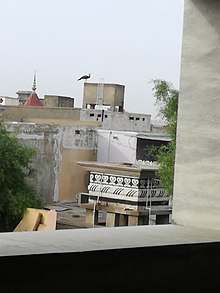
A view from a house window of a peafowl sitting on water tank(top of a house) in Tharparkar district
In Tharparkar district, the peafowls hold great significance and are considered a part of identity, pride and heritage. They are found very commonly across this region. In early mornings they are seen roaming from one house roof to other and locals often offer them grains for feeding. During rainy days such frequency is higher. Peafowls also have great history in Thar. The peafowl of Thar once caught attention of Alexander the Great while he was passing through Sindh. Further, he sent this gift of nature to his mother. Since ancient times, peafowl has remained most integral part of designs and are seen in pottery, rallis and other handlooms and art works in Thar. Many artists, poets and singers from the land of Thar have emphasised peafowl in their work. The Sindhi folk song “Mor Tho Tilley Rana” is one of such example. Peafowl is part of cultural heritage in Tharparkar.
Tharparkar cattle
Tharparkar cattle famous since first World War
Tharparkar cattle originating in Tharparkar district is a dual purpose breed known for both its milking and draught potential. It is also known as White or Gray Sindhi, Cutchi and Thari. As specified in several reports or articles:
“The Tharparkar came into prominence during the first World War when some animals were taken to supply milk for the Near East army camps. Here their capacity for production under rigorous feeding and unfavorable environmental conditions at once became apparent. Since then many breeding herds have been assembled in India and Pakistan. When left on arid pasture the milk production is approximately 1135 kg per lactation, while those animals maintained in the villages average 1980 kg.”
Ralli
Ralli quilt
Ralli are traditional quilts made by women in the Indus Region of the Indian subcontinent. The word Ralli is derived from the local word “ralanna” which means to mix or connect. Ralli are tradition since 4th millennium BC. On trade records from the early 1500s Ralli is listed as an export item to Europe. The tradition of Ralli has passed from mother to daughter for thousands of years. Irrespective of caste, religion, occupation and tribe thousands of women make Ralli. These women belong to under privileged and poor segment who consider it as their source of income. Women spent more than 170 hours for each of this art. Like a textile currency having a value, Ralli was used for exchange of valuable things in ancient Indus Valley Civilization. For Thari rural women, Ralli is vital source of entrepreneurship and skill development. In Tharparkar, Ralli with Peacock designs are very popular.
Kekra Truck (Chakra)

A Kekra truck unloading construction material in Tharparkar
Kekra Truck also called as Chakra by native people, is very common for the local transportation in Tharparkar. This truck is very suitable for sandy routes so it is also called ‘Camel of Thar’. The truck is decorated with various designs and flowers. Since powerful Bedford engines of World War II are used in Kekras, the popularity of this truck is on the peak. Before the roads were constructed in Tharparkar, people along with their livestock and household items used to transport via Kekra. Now, with rise in road connectivity these trucks mostly transport the goods or general items. Modifications to the chassis are done to enhance the loading capacity. A typical Kekra truck is said to have capacity of 12,000 kg. Kekra trucks with traditional Thari decorations has become the tradition of transportation in Tharparkar district.
Notable people

Nihalchand Pabani giving a speech on 14 August (Independence Day)
- Fozia Soomro (1966–2002) – Thari, Marwari and Sindhi folk singer.
- Mai Bhagi (Bhagbhari, 1920–1986) – Known as the Koel of Thar Desert.
- Muhammad Usman Diplai (13 June 1908 – 8 February 1981) – Writer.



